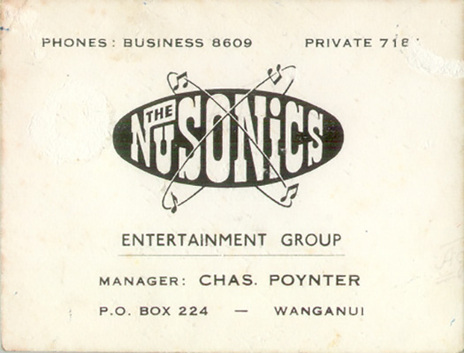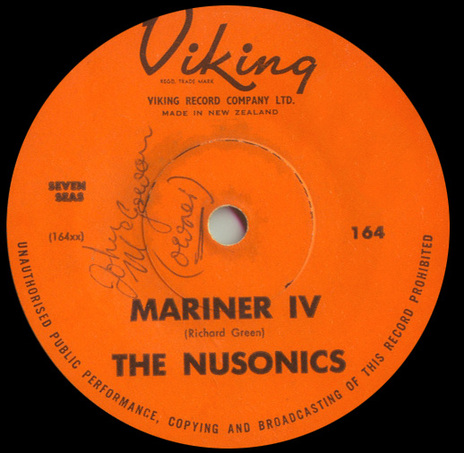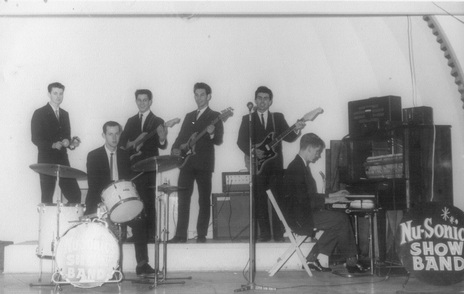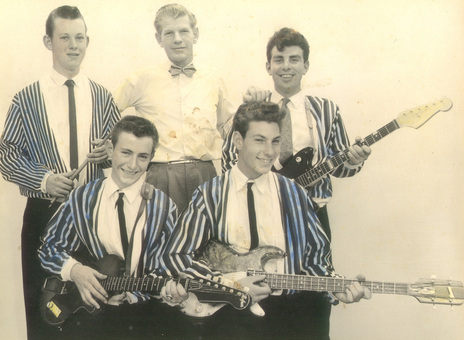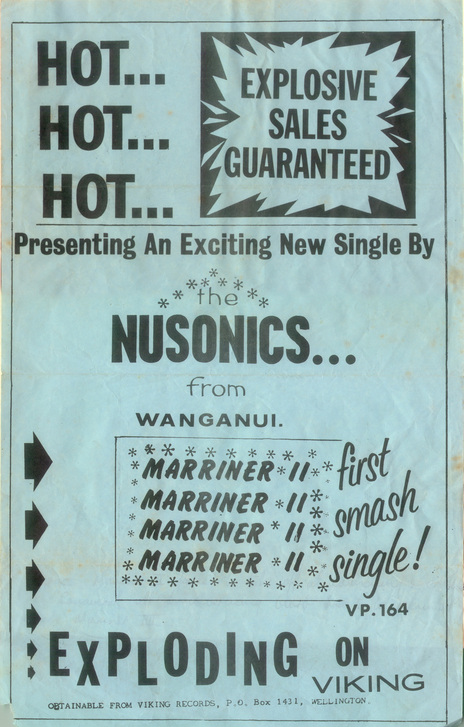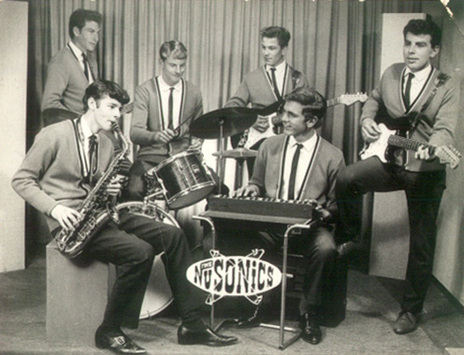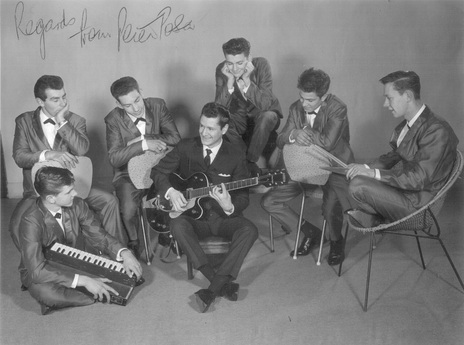Through a period of flux the band's final line-up evolved. Murray Barns replaced Peter Fromont on rhythm guitar, John McGowan took over as drummer, and the band added keyboardist Richard Green, sending their new manager Chas Poynter (later to be long-standing mayor of Wanganui) to recruit the young schoolboy and gain the permission of his parents.
By this stage The NuSonics were already equipped with several competent vocalists (both McGowan and Green are professional vocalists to this day) but they wanted a front man. When they heard John Harrison performing as a guest vocalist with The Minors he was promptly appointed.
The band, by their recent recollection (although there was some debate) were now making three pounds and five shillings per gig – most of which went into the purchase of a PA amp, built by guitarist, composer, and electronics engineer Jim Coyle.
Undaunted, Richard joined a church, signed on as organist, and used their licence to import a Lowrey organ.
In an era when good equipment was difficult to come by The NuSonics were determined to have the best possible. McGowan was taken on with the caveat that he upgrade his drum kit, payments for which initially used up all his personal earnings, and Green was hired largely due to his possession of a Univox — an early monophonic, valve-powered synthesiser that Green purchased from his Physics teacher.
As the Univox could only produce one note at a time, Green soon wanted to acquire something more versatile. Due to import restrictions it proved impossible to upgrade through normal retail channels so, undaunted, Richard joined a church, signed on as organist, and used their licence to import a Lowrey organ.
For the guitarists the early years were equally challenging. Mike, reminiscing about his first bass, a Commodore, described it as "a pig of a thing". Eventually Mike upgraded to a bass he made himself at Wanganui's Railway Workshops and the guitarists equipped themselves with red Fenders, emulating their heroes The Shadows.
Emulation was also a factor when it came to stage presentation – resulting in a series of identifiable band uniforms. One uniform consisted of shiny blue shantung suits modelled on (again) The Shadows. Richard Green wore his, taken out in more than a few places, at the 2007 reunion concert. Another was an emulation of The Dave Clark Five – white skivvies with black buttons. The band repeatedly changed their looks to imitate trending bands, their uniforms made by a local tailor.
For Wanganui bands of this era gigs were usually dances in church halls. These were not as twee as the idea now sounds as by and large they were, at the very least, semi-professional ventures. Regardless, The NuSonics looked further afield.
From a working musician's perspective there was one notable small town within range of Wanganui that was worth a shot. In summer it was a quiet place where the locals didn't want to know anyone from outside. In winter everything changed. Winter was when the money arrived in the form of the skiers’ buses from Auckland. The town was (and still is) Ohakune and the experiences The NuSonics had there clearly loom large in the collective memories of the band.
"We were pretty sharp in suits and all that [but] when we tuned up possums scarpered from the rafters [and] a guy turned up with a rifle and a pig’s head."
So, in the winter months of the mid 1960s, The NuSonics clambered into various dubious vehicles and braved the tortuous Parapara Highway between Wanganui and Ohakune. As The NuSonics told it, "When we got to Ohakune we thought we were pretty sharp in suits and all that [but] when we tuned up possums scarpered from the rafters [and during our gig] a guy turned up with a rifle and a pig’s head, dumped the head on the stage, and started dancing."
As well as performing at dances, hosting gigs upstairs at Begg’s Music shop in Wanganui, and their Ohakune appearances, The NuSonics performed at venues further afield, including Wellington gigs run by Ken Cooper at venues such as The Platterack, The Place, and The Wainuiomata Rock 'n' Roll Club, and performed live to air sessions for Wanganui radio station 2XA.
Ever ambitious, The NuSonics also set their sights on recording. John McGowan recalls, "Chas Poynter hooked us up with Ron Dalton, who was the studio boss of Viking at the time. They were in Newton Road off Symonds Street [in] Auckland opposite The El Matador Restaurant. This was 1964 or 1965."
Despite recording five songs for the Viking label, The NuSonics released only one commercial single, the Richard Green instrumental 'Mariner IV' (originally titled 'Mariner II') backed with 'Call It A Day'. Other tracks, probably covers, recorded at the same session but never released and considered permanently lost were titled 'Come Along My Baby', 'Maybe Baby' and 'I've Had It'. Murdoch Riley of Viking/ Seven Seas suggested the following scenario: "In the early days raw tape was at a premium and under import licence, so I am afraid that the original tape might have been wiped and re-used."
McGowan's recollections of these sessions also support the tape saving theory. "We went to Auckland at our own expense, with a bunch of songs to record, but Viking only wanted instrumentals. We said 'The Beatles are coming! Let’s do some songs!' but they said 'Do instrumentals first and then we’ll see.' After we did three instrumentals we started playing songs. We played on but they refused to record any more. The next week the top song was ‘Please Please Me’ – and we had it learnt that week. We had to! That was what the kids wanted. If we’d recorded those songs we might have had a whole different audience."
McGowan also recalled that the band were allowed to play each song only once and were then asked, "Did anyone make a mistake?" before moving onto the next tune.
Poynter announced that they’d received their royalty cheque – it would almost cover the cost of the dinner.
Following the success of ‘Mariner IV’ in New Zealand and (allegedly) Australia, and Ron Dalton’s as yet unsubstantiated claim that the single had been released in the USA (it was in fact released on Interphon Records (IN-7714), but credited to 'The Masonics' and under the original working title of ‘Mariner II’), the band met for dinner to celebrate their good fortune. Over cigars, which McGowan recalls made them all sick, Poynter announced that they’d received their royalty cheque – and that it would almost cover the cost of the dinner.
The NuSonics disbanded shortly thereafter, although to fulfil commitments the nucleus briefly renamed themselves The 17th Virginians and performed a handful of gigs at Brian Flegg's Wanganui Venue The Cauldron. Barns and Harrison joined Wanganui band Top Shelf, relocated to Wellington and signed to EMI. McGowan & Green teamed up with Brian Flegg & Les Russell to form Wanganui Promotions, the company through which Flegg would take Top Shelf to Wellington and success. Richard Green turned his back on pop music to become an opera singer. McGowan, after living and performing in Auckland and the USA is once again resident in Whanganui and still performs. John Hopkirk is now a guitar teacher in Canterbury.
